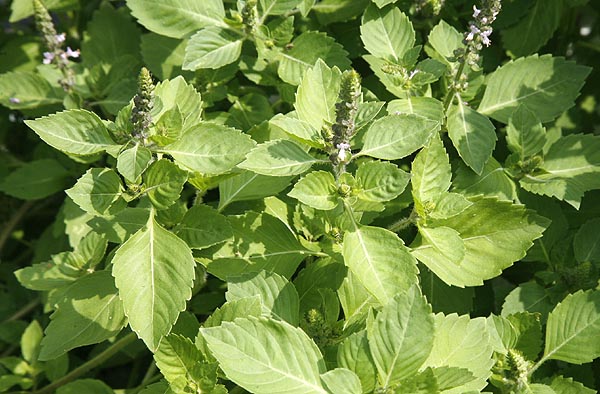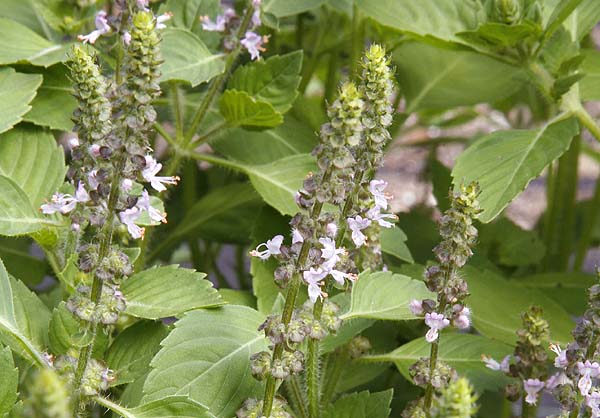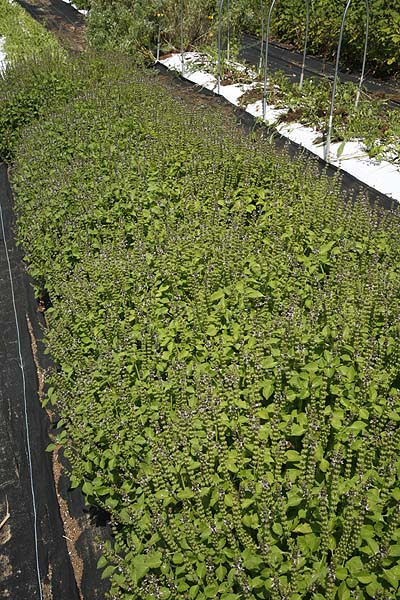One of the best plants to grow and consume for good heatlh. Many alternative practitioners recommend consuming some as a tea, tincture or capsule every day to help promote good health. This plant is very easy to grow but likes full sun and water to keep it healthy. If it gets that it will produce leaves for cutting all summer long. Not fussy about soil type but does best on well drained soils with good amount of organic material. Cut it right down and it will regenerate several times throughout the growing season. If you want pollinators this is the plant to grow. Bees adore Holy Basil and will flock to it as will butterflies and humming birds. Makes a good pot plant as it grows in a short bushy style that will fill any pot, the flowers are attractive and the whole plant has a wonderful basil aroma which is very attractive to humans but disliked by most wildlife including deer and rabbits. If you grow nothing else this year this should be your one plant.
Description of Holy Basil (Ocimum Sanctum /Ocimum tenuiflorum).
Holy Basil has mid green leaves which are oval pointed with serrated edges and fairly deep veins. The leaves are arranged in opposite pairs on square stems that are green and slightly hairy. Flower spikes arise from the tops of the branches on green stalks, green calyx and light purple to light pink flowers. Flowers bloom from the base of the flower stalk upwards with each being about ½ inch (1.2 cm) long. The plant can grow 24- 36 inches (61-91 cm) high and up to 18 inches (46 cm) wide. The leaves have a strong scent of cloves and undertones of licorice. The Latin names Ocimum Sanctum and Ocimum tenuiflorum are used interchangeable for this plant..
Growing Holy Basil (Ocimum Sanctum /Ocimum tenuiflorum) from Seed.
Holy basil plants are easy to grow but the seedlings are slow to develop at first and can be delicate. Starting seed indoors and growing on in pots to a reasonable size before planting out is recommended. Follow our
general growing instructions. Keep compost slightly dry at all times but do not let it dry out entirely. Pot on when seedlings are large enough to handle and plant out after hardening off. Plant out with a 12 inch (30 cm) spacing.
Holy Basil can easily be grown indoors in pots all year around to ensure fresh herb for the kitchen. Starting seeds in early spring ready for outdoor planting will help increase the season length. Seeds can then either be sown throughout the year in pots if desired or sown directly in the ground once all danger of frost has passed.
Germination usually takes about 14-20 days depending on temperature.
Location and Care of Holy Basil (Ocimum Sanctum /Ocimum tenuiflorum).
This basil like all basils prefers full sun. It needs a well drained soil and to be watered regularly, it does not like wet feet. It also likes a pretty rich soil and grows best with a good mulching. The more organic material and fertilizer it gets the richer the leaf growth is. Lush leaves are usually what is required on a basil plant unless its grown as an ornamental. For leaf harvest the addition of a fertilizer with higher nitrogen will increase leaf growth and reduce it the likelihood of flowering. If cared for it will produce a multitude of leaves.
Basil is a tender plant and will not tolerate frost. As soon as the weather turns cold the leaves begin to turn black. In areas where there is not frost the plants can live for two or more years. Basils can tolerate slightly acidic soils. If the pH is lower than 5.7, add a dressing of lime when preparing the soil.
If planting in a pot make sure that the roots have room to grow. These plants are fairly bushy and will grow out forming a more rounded canopy that can fill a pot entirely. So don't plant it with anything else as its likely to crowd it out.
Plant spacing and airflow.
Allow plenty of air space around your basil plants. If growing a row keep plants at least 2 feet (61 cm) apart. If growing in a border keep other plants back slightly to allow for airflow. Don't grow Holy Basil in areas where there is little airflow. Holy Basil can be highly susceptible to fungal molds and allowing good airflow around the plant can greatly reduce the likelihood of this happening to your plants.
Keep chemicals away from your basil.
Don't grow any Basil in a area where it could be sprayed by chemicals, if you use chemicals on your lawn ensure that your basil plants are not right next to it. Try not to grow it near your property boundary where chemicals used by your neighbor may land on your plants. Always wash the leaves well before eating.
Great of decks, boxes and hanging baskets.
Holy Basil is a very versatile plant and can be grown in hanging baskets, pots and even on the windowsill offering fresh basil throughout the winter months. If leaves are harvested regularly the plants can be kept small. This plant is rich in several important nutrients, most notably vitamin A, vitamin C. It also contains high concentrations of carotenoids like beta carotene, and these substances are converted to vitamin A within the body. It may be a good source of iron, potassium, and magnesium depending on what it can extract from your soil.
You can also use basil in the garden as a companion plant to repel aphids, mites, and tomato hornworms.
Pollinators and Holy Basil.
Bees absolutely LOVE Holy basil. They will flock to it when its flowering and ignore other plants. It also attracts butterflies in multitudes, as well as other pollinators and even hummingbirds. If you are keen on attracting pollinators or butterflies then this plant is a must for you. We recommend growing quite a bit of it. Then on the first section cut as it just coming into flower down to about 6" (15 cm) let the rest go longer then cut the second set a week or two later. Cut the last one as the flowers reach the top but before the branches start to produce seeds. In this manner you will have flowering Holy basil all summer long as plants regenerate and flower. You will need to repeat this process at least three times during the year but its worth it to keep the bees and butterflies happy. You can harvest the leaves from the plants you cut for yourself so its win win for everyone.
However if you don't like insects around you don't plant close to a deck or other areas where you will be outside a lot.
Harvesting of Holy Basil (Ocimum Sanctum /Ocimum tenuiflorum).
Holy basil is a short bushy plant. There are two ways to harvest it. Wait until the plants are just about to flower before harvesting your first leaves. If you only want a few at time then pinch off the flowering tops to keep the plant vigorous and use these leaves as you go. If you want to harvest and dry your herb the wait until the plant is just coming into good flower then cut the whole plant down to about six inches from the ground. Leave a few short stems with leaves on. Don't worry that the plant now looks like mainly stalks. In a few weeks the plant will spring back up and look exactly like it did before. Harvesting this way you can cut and 'renew' the plants at least four times during the growing season. This is for zone 6b you may get more or less depending on your zone. Do not let the plants flower for too long or start to make seed if you do this they will not regenerate as they consider they have fulfilled their purpose and will die.
Leaves or whole stems can be dried - in a warm but not hot dark place - for later use. Leaves can also be frozen in air tight bags or they can be packed in jars in olive oil or used to flavor vinegar's for winter use. Make sure you harvest all your leaves before the first frost is due.
Types of Holy Basil
If you do any research you will immediately find that there are many different kinds of holy basil. All of them are also known as Tulsi but they are different plants which often have different properties. Ayurveda has not made this easy. Almost all the true Holy basils are tropical but some are annuals and some are perennials. The most commonly grown is Rama which has the clove like typical basil scent with undertones of licorice. This is what we grow. There is also a purple variety of this which is known as Krishna. It has very similar properties but tends to be a little more hairy. Another variety is known as Temperate Basil, or Kapoor which looks similar to Rama but has a very different aroma and smells more like bubblegum or tutti-frutti. It also bolts to flower very quickly so it not as easy to control and many consider it does not have the same medicinal properties as the other holy Basils. There is also Tree holy Basil - called Vana this is
(Ocimum gratissimum) it's a perennial in warm climates and grows into a six foot or more shrub like tree. That's the simple version if you spend any time on Ayurvedic sites you will discover a huge number of different names for this plant very subtle difference in the plants. Look at the list of 'other names' below to get some idea. Don't get bogged down, the Rama is the one that most of the studies have been conducted on so if you want the medicinal benefits it's a good one to go with.
Edible Uses of Holy Basil (Ocimum Sanctum /Ocimum tenuiflorum)
Holy basil can be used in the same way as sweet basil as the flavor and aroma can be similar. Its great in salads or cooking as well as made into tea. Both the flowers and leaves are edible and the flowers make a great addition to salads. The seeds when soaked in water become mucilaginous and can be used instead of chia seeds. Using basil seeds in this way is very common in India.
Medicinal uses of Holy Basil (Ocimum Sanctum /Ocimum tenuiflorum)
Holy basil has been used for centuries in Ayurvedic medicine and is one of the 'go to' herbs for numerous maladies. There have been a huge number of scientific studies done on this herb for many different medical conditions and Holy Basil has been found to help all of the following. Stress and Anxiety, Diabetes and Blood Sugar Imbalance, Immune Function (Th1 and Th2), Bone Healing ,Inflammation, Cognitive Function, Heart Health, High Blood Pressure, Liver Health, Stomach Ulcers, Antioxidant Activity, Pain management, Radiation protection, Antibacterial Activity, Antiviral Activity, Candida Overgrowth, Biofilm breakdown, Testosterone level increase, Histamine reduction, Cataracts improvement, and many forms of cancer including skin, lung, breast, liver stomach and oral. Many alternative practitioners suggest that everyone should take some Holy Basil every day either as a supplement or as a tincture or tea to improve or keep general health and wellbeing.
Contraindications
The safety of taking tulsi during pregnancy and breastfeeding has not yet been studied, Tulsi may not be good for those with thyroid disease.
Drug Interactions
Taking Tulsi with Valium may increase its effects on the immune system.
Other Uses
The stems are cut into beads for rosaries and an essential oil from the plant is used as an insect repellent.
Other Names. These are just some of the ones we found.
achhaphun, Ajaka, albahaca morada, Amrita Tulsi, badroj, badrooj, bahumaniri, Bai Horapa- , bana tulasi, Baranda, Basil Icum, Basilic des moines, Basilic sacre, BasilicBasilïenkraut, BasilkortHoropa, BazilikAlbahaca, bazsalikom levél, Bhutaghini, bhutaghn, Bhuteshta, Bidai, Brinda, Bryanda, daun lampes, folium ocimi sancti, Gaggera, Gouri, green tulsi, Guna, heen maduruthala, helig basilika, holi basil, Holy Basil, Hsiang tsai, huong nhu t¡ia, im-khim-lam, Indian Basil, jagu lu myah, Jericao, Kala tulsi, Kamangi, kamimebouki, Kaphrao, Kapour, kaprao, Katriin, Katu, kemangi, kemangi laki, kemangi utan, KemangiBasilico, KemangiBelanoi, kom ko dong, kra phrao, Krapow, Krishna tulasi, Krsiatulasi, Laghu, lampas, loko-loko, Lo-Le, Maduru-Tala, Maeng-luk, Mal-Tulasi, manchi tulasi, Manghk, Manjari, manjericão-branco, Meboki Selaseh, monk's basil, Mreah preu, Mreahs prow, Nagamata, Nalla Thulasi, nalla tulasi, oku, Parnasa, Patrapuspha, peihan, persian, pti basilic, raihan, Rama Tulsi , Rau QueRasa, rayhhan, rehan, reihan, Rooksha, rough basil, ruku-ruku, sacred balm, Sacred Basil, saling-kugon ma, Saph'au, selaseh puteh, Selasih, selasih, Sheng luo le, shree tulasi, Shyam Tulsi , solasi, sri tulasi, Sulasi, SulasiMan , surasa, Surasadi gana, Surasah, sursa, Suvasa tulasi, Suwenda-Tala, Svasahara gana, tamole, Tarp hao, Te marou, TeekshnaVirya, Thai basil, thiru theezai, thiruthazhai, thulasi, Tikta, tjlsi, tompanamma, toolsee, Trittavu, tulas, tulasa, tulashi, tulasi, Tulasi chajadha, TulasiRaihan, Tulsi, Tunrusi, UshnaVipaka, Vana, Vana Tulsi, vishnu tulasi.









